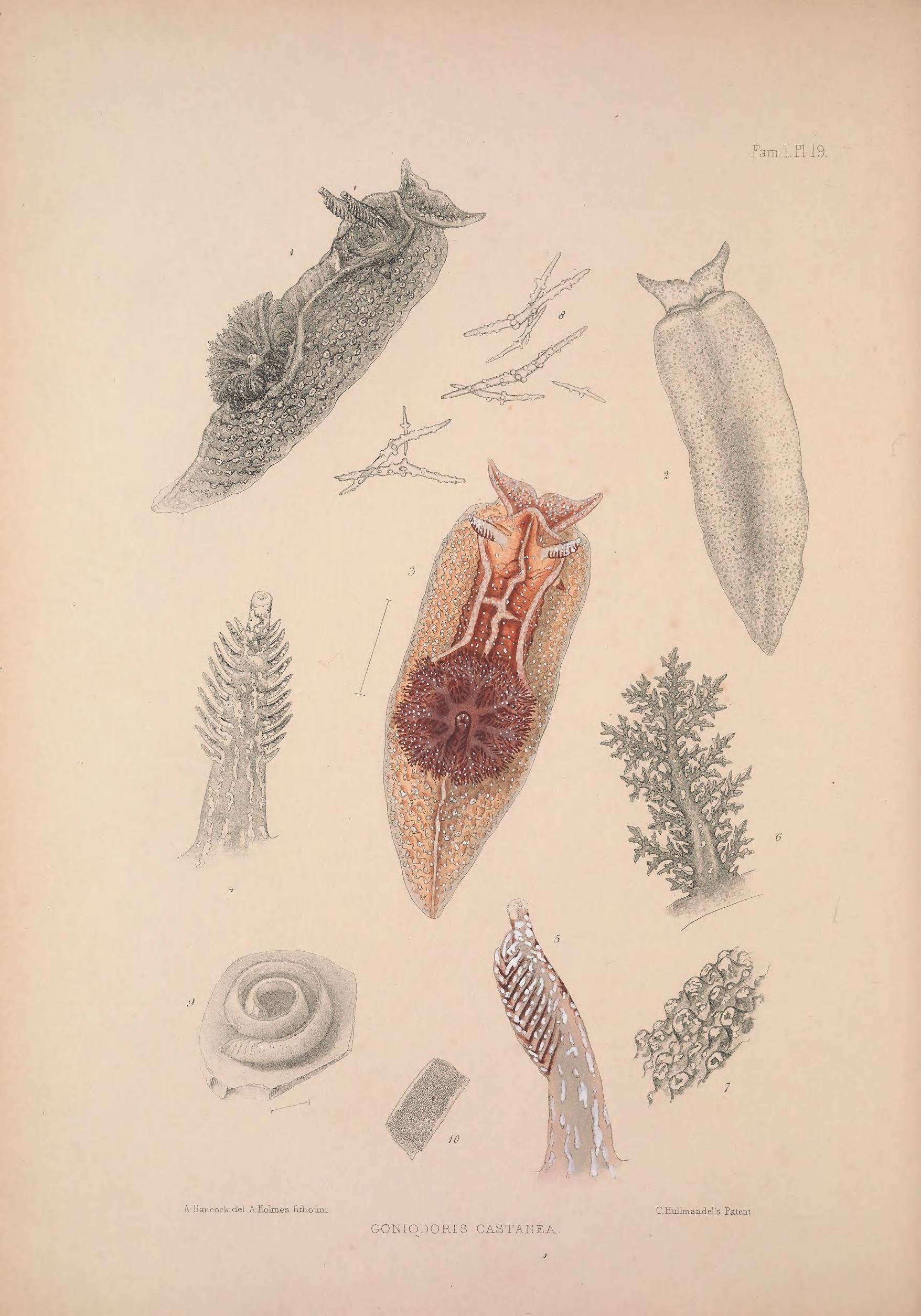|
Goniodoris Castanea
''Goniodoris castanea'' is a species of sea slug, a dorid nudibranch, a marine gastropod mollusc in the family Goniodorididae. Distribution This species was first described from Salcombe Estuary, Devon. It has subsequently been reported widely in Britain and Ireland and from Norway to the Mediterranean Sea.Thompson, T.E. and Brown, G.H., 1984. Biology of Opisthobranch Molluscs, Volume II. The Ray Society. 229 pages 41 plates, 40 figures, p. 125.Trainito, E. & Doneddu, M., 2014. Nudibranchi del Mediterraneo. 2nd Edition. Il Castello. , 192 pages. Description This goniodorid nudibranch is variable in colour, usually red-brown or dark purple but also bright red. Most individuals have scattered irregular small patches of white or grey all over the body.Picton, B.E. & Morrow, C.C. (2015)''Goniodoris castanea'' Alder & Hancock, 1845. n/nowiki> Encyclopedia of Marine Life of Britain and Ireland. Accessed on 2015-10-20 Its body length is usually 15 mm. The maximum recorded body ... [...More Info...] [...Related Items...] OR: [Wikipedia] [Google] [Baidu] |
Joshua Alder
Joshua Alder (7 April 1792 – 21 January 1867) was a British cheese, cheesemonger and amateur zoologist and malacologist. As such, he specialized in the Tunicata, and in gastropods. He was a member of the Hancock Museum, Natural History Society of Northumberland and Durham, and an early member of the Literary and Philosophical Society of Newcastle upon Tyne, alongside Joseph Swan and Robert Stephenson. He corresponded with Charles Darwin. His drawings are in the collections of the Great North Museum: Hancock and the British Museum. Ravensworth Terrace From 1841 to 1857 Alder was a tenant at 5 Ravensworth Terrace in the Summerhill area of Newcastle upon Tyne, which he shared with his sister Mary, a woman of independent means, and their two female servants. During this time, he ran a cheese shop in The Side, Newcastle upon Tyne, The Side, a street in central Newcastle. He sold that business and became a shareholder in the Northumberland District Bank, and a gentleman of leis ... [...More Info...] [...Related Items...] OR: [Wikipedia] [Google] [Baidu] |
Family (biology)
Family ( la, familia, plural ') is one of the eight major hierarchical taxonomic ranks in Linnaean taxonomy. It is classified between order and genus. A family may be divided into subfamilies, which are intermediate ranks between the ranks of family and genus. The official family names are Latin in origin; however, popular names are often used: for example, walnut trees and hickory trees belong to the family Juglandaceae, but that family is commonly referred to as the "walnut family". What belongs to a family—or if a described family should be recognized at all—are proposed and determined by practicing taxonomists. There are no hard rules for describing or recognizing a family, but in plants, they can be characterized on the basis of both vegetative and reproductive features of plant species. Taxonomists often take different positions about descriptions, and there may be no broad consensus across the scientific community for some time. The publishing of new data and opini ... [...More Info...] [...Related Items...] OR: [Wikipedia] [Google] [Baidu] |
Botryllus
''Botryllus'' is a genus of colonial ascidian tunicates in the family Styelidae. Species Species in this genus include: * '' Botryllus arenaceus'' Monniot, 1988 * '' Botryllus aster'' Monniot, 1991 * '' Botryllus closionis'' Monniot, Monniot, Griffiths & Schleyer, 2001 * '' Botryllus compositus'' Tokioka, 1967 * '' Botryllus delicatus'' Okuyama & Saito, 2001 * '' Botryllus eilatensis'' Shenkar & Monniot, 2006 * ''Botryllus elegans'' (Quoy & Gaimard, 1834) * '' Botryllus firmus'' Monniot & Monniot, 1996 * '' Botryllus gregalis'' (Sluiter, 1898) * '' Botryllus horridus'' Saito & Okuyama, 2003 * '' Botryllus japonicus'' (Oka, 1931) * '' Botryllus leptus'' Savigny, 1816 * '' Botryllus maeandrius'' (Sluiter, 1898) * '' Botryllus magnus'' Ritter, 1901 * '' Botryllus mortenseni'' Millar, 1964 * '' Botryllus ovalis'' Monniot, 1988 * '' Botryllus perspicuum'' Herdman, 1886 * '' Botryllus planus'' (Van Name, 1902) * '' Botryllus primigenus'' Oka, 1928 * '' Botryllus promiscuus'' Okuyama ... [...More Info...] [...Related Items...] OR: [Wikipedia] [Google] [Baidu] |
Tunicate
A tunicate is a marine invertebrate animal, a member of the subphylum Tunicata (). It is part of the Chordata, a phylum which includes all animals with dorsal nerve cords and notochords (including vertebrates). The subphylum was at one time called Urochordata, and the term urochordates is still sometimes used for these animals. They are the only chordates that have lost their myomeric segmentation, with the possible exception of the 'seriation of the gill slits'. Some tunicates live as solitary individuals, but others replicate by budding and become colonies, each unit being known as a zooid. They are marine filter feeders with a water-filled, sac-like body structure and two tubular openings, known as siphons, through which they draw in and expel water. During their respiration and feeding, they take in water through the incurrent (or inhalant) siphon and expel the filtered water through the excurrent (or exhalant) siphon. Most adult tunicates are sessile, immobile and perman ... [...More Info...] [...Related Items...] OR: [Wikipedia] [Google] [Baidu] |

